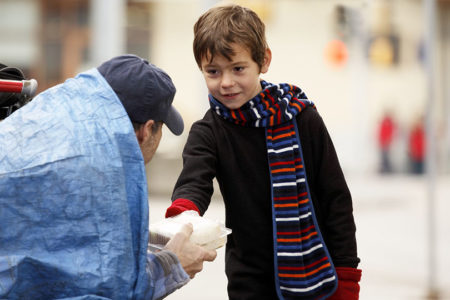While We Were Still Sinners
I will never forget the day I visited the infamous Dandora Dump on the outskirts of Nairobi, Kenya. The stench overwhelmed me as I witnessed young children scouring smoking mountains of toxic trash for something to sell or eat. Tragically, living in filth and pollution was their way of life. I plugged my nose and began to turn away, when I suddenly realized this ugly scene summed up a person’s sinful and hopeless existence without Jesus Christ.
The truth is that our holy God cannot tolerate sin. When we fully grasp the utter depravity of our condition, it becomes difficult to comprehend the fact that God loved us even while we bore the stench of sin (Rom. 5:8). His great love for sinners prompted Him to send His only Son, Jesus, as a baby to a humble, smelly stable in Bethlehem. A stable seems an unlikely birthplace for the precious Son of God, yet it indicates the depth of God’s love and how far He was willing to go to reconcile sinners to Himself.
God sent Jesus to Earth on a search-and-rescue mission. He came to seek and save that which was lost (Lk. 19:10). Jesus carried out His mission all the way to the cross of Calvary, perfectly reflecting His Father’s love. Much to the discomfort of the religious leaders of the day, Jesus became widely known as a friend of sinners.
What Did Jesus See?
What did Jesus see in sinners anyway? He pursued those whom society had branded as undeserving and unlovable, whether it was dishonest tax collectors like Levi (5:27) and Zacchaeus (19:1–10), the adulterous woman at the well (Jn. 4), or the demon-possessed Mary Magdalene (Lk. 8:2). Jesus saw potential in the most unlikely people. Ask yourself a critical question: How do you look at sinners?
I can vividly recall the first time I visited a rescue mission as a young child with my father. The atmosphere seemed chaotic, and I struggled to process all that I saw. Frankly, I was petrified. Filth and hopelessness were everywhere. My knees literally knocked as I struggled to perform a simple piano solo. When I returned to my seat, I wrestled with my thoughts: What in the world am I doing here? Is it possible that Jesus really loves these people?
If we are brutally honest, our natural tendency is to look at down-and-out sinners with disdain. We keep a safe distance and quietly assume the chance of them coming to Christ is slim to none. How quickly we forget where we came from. We, too, were once “dead in trespasses and sins” (Eph. 2:1). Sin was also our way of life. Even our good deeds were like “filthy rags” to God (Isa. 64:6). None of us deserves God’s grace. Where would you be apart from God’s amazing, unmerited love?
There is no such thing as a sinner who is too far gone. No heart is unreachable. Jesus can transform any sinner into a new creation. Levi left his tax office and became the apostle Matthew who penned the Gospel of Matthew. The woman at the well became a catalyst for introducing many Samaritans to Christ, and Mary Magdalene was the first person to see the resurrected Savior (Mk. 16:9). Talk about realized potential. Yet probably none of these unlikely converts would even have registered on our radar screens.
Jesus modeled how to love sinners. Just imagine what the Lord can do in the life of your hard-hearted neighbor, your prodigal family member, or even your foul-mouthed coworker. Sinners who enter into a personal relationship with Christ have unlimited potential because God’s great love changes everything.
Where Did Jesus Sit?
Jesus never missed an opportunity to interact with people He was trying to reach. He regularly dined with flagrant sinners. After Levi left his tax franchise to follow Christ, he immediately held a huge banquet in his home to introduce Jesus to his fellow tax collectors. The men must have wondered, Who is this Jesus, anyway? What power does He possess that changed Levi’s life?
Jesus sat with sinners on many other occasions throughout Scripture. Luke 4:20 records that Jesus sat down in the synagogue to speak to a hostile audience. Matthew 26:55 says He sat with people daily while teaching in the Temple, and Luke 7:36–37 records that Jesus sat down to eat in the home of a Pharisee and was joined by a woman with a sinful reputation. Jesus pursued opportunities to sit with sinners.
Why is this fact important? What do you normally do when face-to-face with those who need Christ? Contact typically takes place while we stand; and conversations tend to be awkward, hurried, and superficial. After all, we have places to go and people to meet. When was the last time you took the opportunity to sit down and spend time with someone who desperately needs Christ?
Not long ago, I found myself seated at a table across from a stranger in a local restaurant. The man was unkempt, and it was clear he had led a hard life. We engaged in light conversation for a few moments, and then I deliberately turned away for what I had hoped would be a quick and quiet lunch. Then unexpectedly, the man began to share his life story in detail, including his anger toward God. For a fleeting moment, I actually considered packing up my lunch. Then the Holy Spirit convicted me. This was exactly the type of man Jesus came to seek and save. Jesus loves this man, and I need to reflect the same type of love.
We should love sinners the way Christ loves them and seize every opportunity to sit and talk with them, sharing with them the good news that Jesus came to seek and save those who are lost. It is the least we can do since God sent His Son Jesus to rescue us—even while we were still sinners.








1 thought on “While We Were Still Sinners”